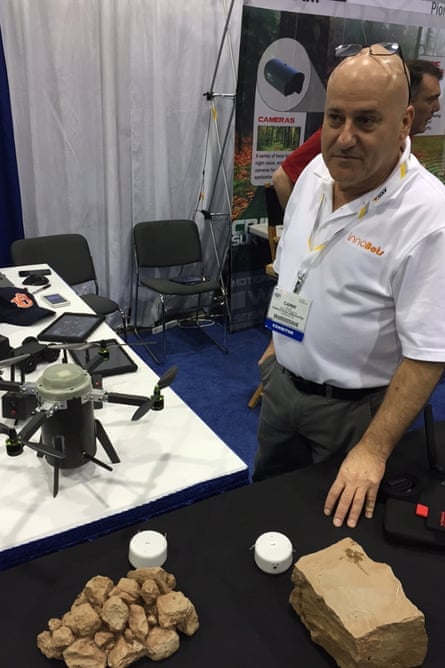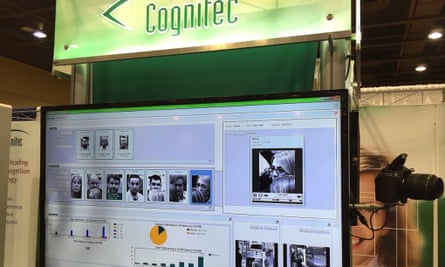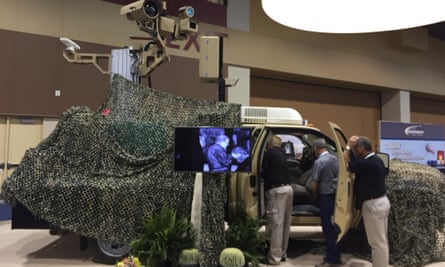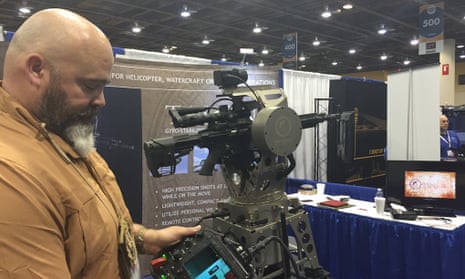There were a couple of rocks on Carmi Peleg’s table, next to a small drone, but he did not really want to talk about them. Of course, they weren’t really rocks, but spy cameras, because this was the Border Security Expo, a surreal annual trade fair where surveillance companies flirt with US government officials in hopes of cashing in on the border technology bonanza.
“They use [them] in police departments in the US,” Peleg said of his rock-cameras. “A lot of stuff. But that’s the only thing I can tell,” he said. His company – innoBots – also sells drones and robots that fit inside backpacks.
A few feet away, another vendor touted some of the world’s most advanced radar technology, capable of detecting a migrant hiding behind a bush hundreds of yards away.
The US government’s appetite for grandiose and risky border technology projects was suppressed by the failure of the Secure Border Initiative, a programme launched in 2005 that saw Boeing contracted to use cameras and sensors to build a “virtual fence”. It was cancelled in 2011 after costing taxpayers about $1bn to cover a 53-mile stretch of the 2,100-mile long border with Mexico.
Officials are now trying to use more reliable technology on a smaller scale, having first thrown people at the problem. The number of border agents has risen to about 21,000, up from 5,000 two decades ago. The boots on the ground are getting iPhones in their hands, equipped with fingerprint apps with the goal of identifying migrants as soon as they’re stopped, rather than at often-distant processing centres.
The crisis prompted by the influx of unaccompanied minors into the Rio Grande Valley last summer, when infrastructure was overwhelmed, led the government to realise that technology that leads to quicker processing will help it cope more efficiently with any future surge.
The US government is also expanding its ability to scan train cargos crossing the southern border and is becoming more interested in maritime surveillance, particularly in the Great Lakes – possible good news for amphibious drone manufacturers.

Instinctively reluctant to trust the federal government with anything, Texas has its own plans, such as Operation Drawbridge: a 1,500-camera array that it is seeking to expand to 5,500. They’re dubbed “game cameras”, as if the Texas Department of Public Safety were hunting deer.
In a big conference room in the Phoenix Convention Center this week, senior Homeland Security officials gave statistics-heavy speeches to a rapt audience of executives, sales reps and law enforcement officials, each listening for hints about policy shifts and strategic goals that could make their products just what the government is looking for. Then, in the afternoon, attendees crossed the lobby to the exhibition room, where private companies hawk their wares.
Acronyms abound: CBP, DHS, JTFW, VACIS, UAS, TARS. In the exhibit hall, it’s mostly a case of WTF? The room resembles Q’s gadget lab from the Bond films, with 110 exhibitors hawking products from the basic to the bonkers.
“This is the border-industrial complex,” said James Cooper, a professor at California Western School of Law, who was attending the conference to research a book. “This is like Dwight D Eisenhower meets the medieval fortress. You’re seeing this privatisation of what is an inherently governmental function.”
Mark Borkowski, assistant technology commissioner for the Customs and Border Protection agency, said it was more a question of market research.
“I don’t believe that too many people have gone into that hall and said: ‘Ooh, that widget I want to buy right now.’ But what we do do when we go into the hall is go: ‘Oh, that’s available, or you have that kind of a capacity?’” he said. “It’s a homework kind of thing.”
The Expo is not designed to be a forum for political and cultural analysis of border issues. The bureaucrat-speak and boys-with-toys geek thrills make the event feel deceptively abstract, hermetically sealed from the human dramas, and, often, tragedies of border crossings and cartel activity: the narratives of evasion and capture, life and death, that unfold daily in the brutal desert 150 miles to the south and are partly shaped by the results of networking and deal-making in this windowless, air-conditioned two-day shopping mall.
Borkowski said that biometrics “is a big growth industry and potential”: good news for the likes of Cognitec, a German company that has built the sort of facial recognition technology that not only identifies passers-by with virtually unerring accuracy but can also tell gender, ethnicity, and even age range.
The refining of this technology is moving us closer to a planet where everyone in important public spaces is tracked, identified and assessed by software that can only be tricked by helmets or extensive plastic surgery.
The possibilities at airports, the border and other high-profile potential terrorist targets are obvious. But the equipment has other, less predictable uses: tracking celebrities, say, so the paparazzi could be alerted if Jon Hamm or Ben Affleck walks into a baseball stadium.
“Fingerprint; iris; the ultimate evolution of that is facial recognition,” said Cognitec’s Shaun Hilditch. “Everyone’s face is so unique, as a fingerprint is, but what makes facial recognition better is you don’t have to touch anything.” He said that the success rate is close to 100% even for people wearing caps and hoodies. The software can work using a tiny CCTV-esque camera costing as little as $100. Customers include casinos and banks, Hilditch said, adding that the healthcare industry is also looking into it as a way of giving patients access to private data that is more secure than using passwords.

Black Diamond offers location technology that promises to improve communication between remote forces and command centres by providing visualisations of information that would normally be radioed in, such as the location of enemy forces.
“Shortens the kill chain,” enthuses a promotional leaflet, which features an image of a shadowy hooded figure stabbing the world with a sword. Forward Air Control Utility Suite can help, “whether it’s an A-10 lining up for a gun run, an AC-130 in orbit ready to engage enemies in Danger Close range of friendlies, a Howitzer miles away ready to lay rounds down on a surface to air threat, or even a Ticonderoga Class Cruiser off the coast ready to engage hardened targets during an amphibious assault.”
Or maybe drunk fans getting rowdy at the Super Bowl. Richard Stone, with the company, said it is looking to expand into sports events to help police better manage safety and crowd control.
A Texas firm pitched TALON, a gyro-stabilisation platform designed to help marksmen fire more accurately from helicopters and moving vehicles, even allowing them to operate weapons remotely from a handheld controller that resembles an oversized video games console.
Business is clearly booming. One estimate expects revenues from the global border security and biometrics market to double to $32.5bn by 2021 – roughly half the size of the Department of Homeland Security’s 2015 budget.
In a sense, we are all on the border. And ot only because, according to the ACLU, two-thirds of Americans live within 100 miles of a border, putting them within the scope of Border Patrol operations.
It’s also because, as equipment becomes cheaper, easier to use and more portable, and since private companies don’t usually mind who they sell to, it is within reach of local police departments as well as multibillion-dollar government agencies, facilitating the militarisation of law enforcement. In addition to some of the most powerful government border security officials, wide-eyed local police officers also wandered the halls, shopping for cool stuff, leaving their business cards in jars next to bowls of candy.
“We’ve found situations where we went out and got technologies that we thought were useful on the border, then the people who produced those have gone out and created markets for state and local law enforcement,” Borkowski said. “It’s a two-way street. Sometimes it starts with a market with state and local and comes to us.”
Near the entrance hall stood a fake cactus with a covert camera embedded into the central stalk: a ruse tried to great effect by the sheriff’s department in Tucson in 2012, leading to the arrest of more than 30 people at a hotspot for antisocial behaviour.

A dummy with a bloody dagger through its head was visible past the drawn curtain of a portable privacy barrier designed to discourage rubbernecking at accident scenes.
Body Worn: The Ultimate Witness promises to solve the issue of police officers failing to turn on their body cameras. Their lenses are built into protective vests and switch on automatically when officers get out of their vehicles or arrive at a crime scene, with video streaming in real time straight to headquarters. The company’s Anthony Baldoni said that “quite a few departments” are getting ready to buy in the next two months.
The number of southwest border patrol agents has risen by about 3,000 since President Obama entered the Oval Office, and fencing and surveillance systems have more than doubled, according to the administration.
“The border today is transformed. Border communities are safer than the interior locations of each of the border states,” former Border Patrol chief David Aguilar said in a speech.
But it’s not in the interests of any of these companies to agree that the frontier is tight and that the threat from criminal gangs or terrorists is being tackled correctly. “Obama says he’s tough on the border, but everybody knows he’s not,” one vendor said.

Comments (…)
Sign in or create your Guardian account to join the discussion